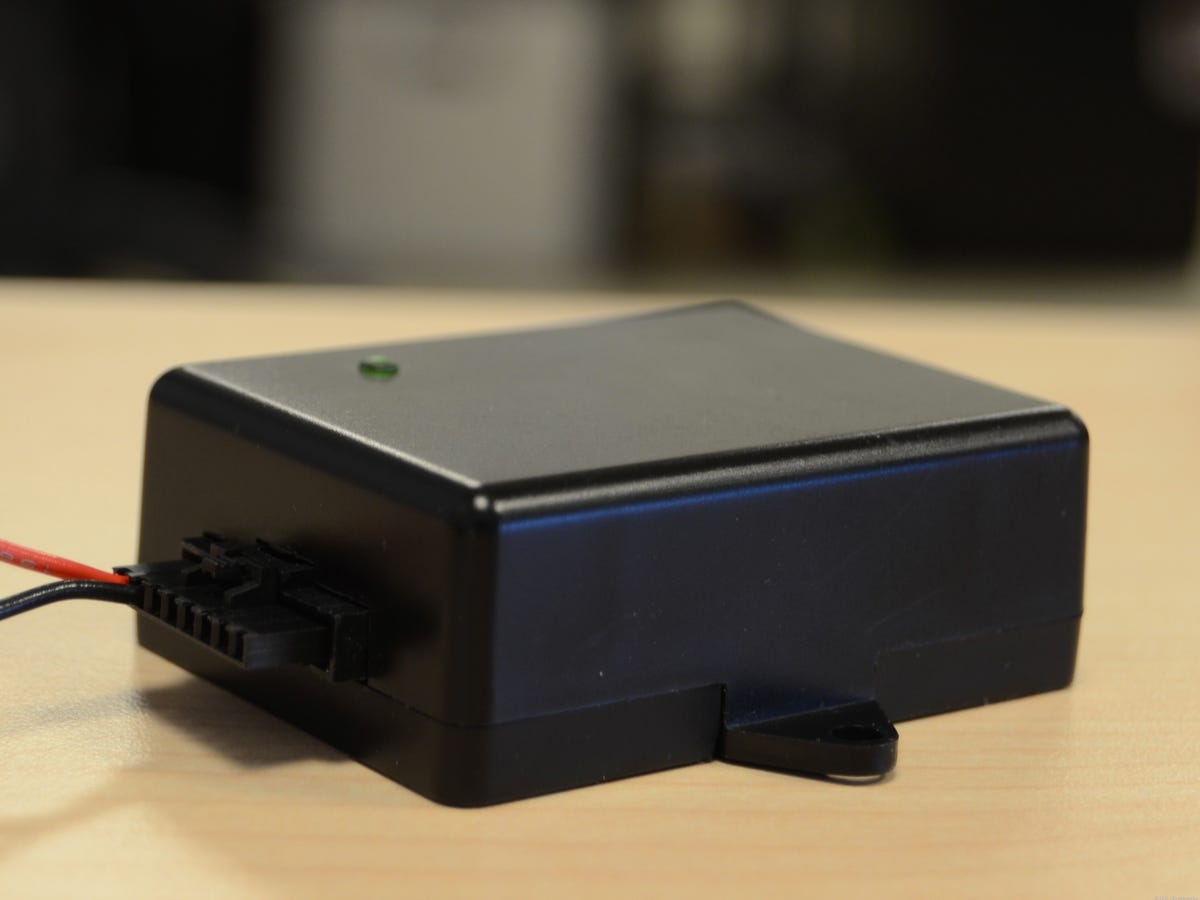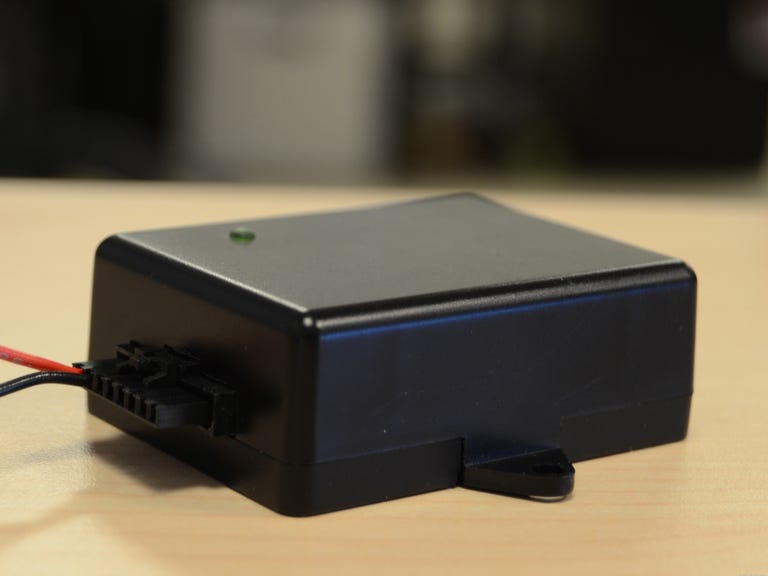 Why You Can Trust CNET
Why You Can Trust CNET TextBuster review: Text- and app-blocker helps keep eyes on the road
When your teen driver can't keep his eyes on the road, who ya gonna call? TextBuster!
When your teen driver can't keep his eyes on the road, who ya gonna call? TextBuster! Gave your kid the keys, but wanna keep Facebook on hold? Who can you call? TextBuster!
The Good
The Bad
The Bottom Line
Sorry, I simply had to get the obvious jokes out of my system.
TextBuster is a product that promises to eliminate driver distraction by blocking text messages and inappropriate apps when a phone is used while in the car. It's got a clever name and makes lofty promises, but I've seen both before, so I installed the TextBuster in my car to see if the device was worthy of my catchy theme song.
What is it?
The TextBuster is a two-part system. The first bit is the physical hardware that is purchased from a retailer and installed in the car. The second half is an app for Android or BlackBerry devices that is installed on the smartphone. No iPhone version of the app is available, presumably due to iOS' restrictions on what you can and can't do with the launcher and Bluetooth connection.
The TextBuster hardware is a small black box, about the size of a large box of matches, that features a connection point for an included wiring harness and two eyelets for holding the TextBuster in place (either with the included zip ties or your own screws). Aside from a tiny indicator light that glows green when the TextBuster is powered on and ready to communicate with nearby phones, there are no physical control or indicators on the device itself.

Installing the hardware is as simple as connecting two wires. One wire for power gets plugged into the host car's fuse box with an included connector. The other wire ends with a circular terminal and gets grounded to bare metal somewhere on the car's body. Zip-tie the black box and its wires out of the way and the installation is done.
Meanwhile, you install the TextBuster app and a companion TextBuster Watcher app on the Android or BlackBerry phone that needs text-busting. Search, click, and install: this bit should be significantly easier than the hardware installation.
With both installations done, start the car and look for the green indicator light on the hardware, then launch the TextBuster app. The app will prompt you to activate Bluetooth if it's not already active on the phone, and make a connection to the TextBuster hardware.
What does it do?
When the TextBuster app detects a signal from the TextBuster hardware, it assumes that you're driving and displays a TextBuster splash screen, obstructing the Android interface. Hit the home button and within a matter of seconds, the TextBuster splash screen reappears. Hit the back button or attempt to use the app switcher and TextBuster quickly smacks down these and any other interactions with the device. Notifications are also hidden.
When you shut down the car's engine, the TextBuster hardware should also deactivate and normal operation of the smartphone should resume.
By blocking notifications and applications, TextBuster not only prevents the driver from interacting with text messages, but also with instant messages, games, video apps, and social-networking services while driving.
The exceptions to the rule are navigation applications and phone calls. The TextBuster splash screen includes shortcuts to either of these functions. On an Android phone with multiple navigation apps installed, you'll likely be given a choice of navigation apps due to the way that the OS handles app defaults. Unfortunately, TextBuster will recognize only Google Maps as a legitimate navigation app and quickly punted me out of alternatives such as Waze and Scout. Additionally, attempting to use Google Voice Search to locate a destination from within the Google Maps interface counts, to the watchful eye of TextBuster, as launching a separate app and caused TextBuster to send me back to the drawing board of the lockout screen.
Tapping the Phone button on the TextBuster lockout screen just brings up the stock dialer app, which doesn't really seem very well suited for in-car use. As with the navigation app, attempting to use a voice dialer causes TextBuster to send the user back to the lock screen.
Interestingly, it seems that the TextBuster hardware doesn't actually do anything aside from notify the app that the host car's ignition is on with the presence of its Bluetooth signal. This makes me wonder if TextBuster could offer a similar, less expensive product that associates with the device ID of a vehicle's OEM Bluetooth hands-free system without the need for additional hardware.
Web management and alerts
When the app is installed on the smartphone, I was surprised that it prompted me, the user, to create an account with a username and password. It turns out this is partially to keep a conniving teen from temporarily disabling the app, but it also gives the account holder access to a Web interface through which all of the information gathered and uploaded by the TextBuster hardware can be managed.
Here users -- most likely concerned parents -- can view what trips TextBuster has logged and learn the last known location of the TextBuster hardware or the phone running the app. Users can also set up alerts, allowing them to receive an SMS notification when the TextBuster app has been tampered with.
Account managers can also set up geofences, virtual boundaries on a map that mark safe or unsafe zones, and be notified thanks to the phone's GPS antenna when it enters or leaves one of those zones. Alerts can also be sent if the car exceeds a preset speed or if it's driven during forbidden hours.
Drawbacks
The TextBuster hardware feels a bit chintzy and rattles a bit when shaken. In fact, I was able to pop its black plastic chassis apart with just my fingers to reveal the rather simple internals. (No worries, the whole thing just snaps back together.)
While we're on the subject of hardware, installing this version of the TextBuster is relatively simple, but is probably a bit too involved for many drivers I know -- these are the sort of people who'd want to keep tabs on their teen's driving, but maybe don't feel comfortable poking around with their vehicle's electrical system. TextBuster offers an optional OBD-II connection that allows the hardware to draw its power from the vehicle's diagnostics port, simplifying the installation to a plug-n-play affair, but that's a $49 accessory purchase.
On the app side, TextBuster requires that Bluetooth be active on the host phone so that it can know when the hardware comes alive, and it must constantly keep the Bluetooth receiver alive, even when you're not in the car, which can be a drag for users obsessed with power management.
I'd also like to see the app not block voice command pop-ups and the voice-dialer app. In fact, TextBuster could go a step further and add a shortcut on the lockout screen that triggers the host phone's voice dialer. Being able to customize which apps are on TextBuster's safe list would allow Android users -- who are used to having a choice of apps -- to take advantage of alternative navigation apps (like Waze or Scout) or voice-command apps (such as Vlingo InCar) that in many ways may be better suited for use on the road than Google's defaults.
I also take issue with the way that TextBuster handles phone calls. An app of which the sole function is to encourage safer driving should, first, feature larger buttons for its two functions (phone and navigation) and then shouldn't just dump users into the stock dialer (with its small, fiddly contact list) when the Phone button is pressed. I'd like to see an update to this app that presents the driver with just a few speed-dial presets with large, easy-to-hit buttons on the lockout screen.
Finally, the app can be pretty easily disabled by a tech-savvy teen, either by simply uninstalling the software or by freezing its operation with an app like Titanium Backup. The Web-connected aspect of the application, the online interface, and the notification system somewhat mitigate this, but still leave some gaps in the system's armor. To expect 100 percent reliability against a teen truly determined to circumvent the system is unreasonable, but I feel that it's important to point out the weaknesses.
In sum
The TextBuster system is a good idea, but its execution is perhaps a bit too extreme. On the positive side, it does exactly what it claims to do. In its native state, the hardware and app combination create a nearly impermeable shield between drivers and the various apps on their phone that are inappropriate for use in a moving vehicle. Drawing on the host phone's data connection for location tracking, geofences, and notifications as well is a clever use of available resources without incurring additional costs for monitoring.
However, there is much room for improvement. I've already outlined how I'd like to see the TextBuster app tweaked to be both safer and easier to use. All of these changes could be easily fixed with an update, making for a less annoying experience for the driver being blocked without compromising the system's goal of circumventing driving-inappropriate apps.
However, cost is the biggest issue to consider for this system. Even at the discounted price of $179 at the time of this review (down from the regular MSRP of $199.95) the TextBuster is a hard pill to swallow, especially when you consider that what you're really buying here is the app -- the TextBuster hardware's sole function, it seems, is to trigger the app's "driving" state and likely costs relatively little to manufacture -- and the online-monitoring and alerts system.
Drop the price significantly by making the online-monitoring portion an optional, premium feature or offer a less expensive, hardware-free version that lets account managers assign the host car's OEM Bluetooth system to be used as the "driving" trigger and TextBuster will have made a believer out of me.


